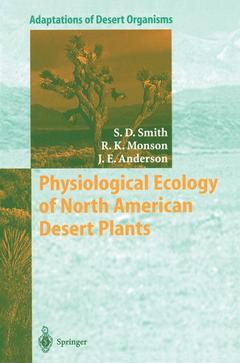Description
Physiological Ecology of North American Desert Plants, Softcover reprint of the original 1st ed. 1997
Coll. Adaptations of Desert Organisms
Authors: Smith Stanley D., Monson Russell, Anderson Jay E.
Language: French
Subjects for Physiological Ecology of North American Desert Plants:
Approximative price 52.74 €
In Print (Delivery period: 15 days).
Add to cart
Publication date: 10-2012
288 p. · 15.5x23.5 cm · Paperback
288 p. · 15.5x23.5 cm · Paperback
Description
/li>Contents
/li>
Following a description of the physical and biological characterization of the four North American deserts together with the primary adaptations of plants to environmental stress, the authors go on to present case studies of key species. They provide an up-to-date and comprehensive review of the major patterns of adaptation in desert plants, with one chapter devoted to several important exotic plants that have invaded these deserts. The whole is rounded off with a synthesis of the resource requirements of desert plants and how they may respond to global climate change.
Prologue.- 1 North American Deserts: Environments and Vegetation.- 1.1 The Deserts of North America.- 1.2 Abiotic Features of North American Deserts.- 1.2.1 Climate.- 1.2.2 Geomorphology and Soils.- 1.3 North American Desert Vegetation.- 1.3.1 Communities of the Major Deserts.- 1.3.2 Historical Biogeography of North American Deserts.- 1.3.3 Spatial Pattern in Desert Vegetation.- 1.3.4 Community Dynamics: Succession, Fire and Desertification.- 1.4 Structure and Function of North American Desert Ecosystems.- 1.4.1 Primary Production.- 1.4.2 Biogeochemistry and Nutrient Cycling.- 2 Plant Processes and Responses to Stress.- 2.1 Photosynthesis in Desert Plants.- 2.1.1 Photosynthetic Pathways Among Desert Plants.- 2.1.2 Photosynthetic Responses to the Environment.- 2.1.3 Diffusional and Metabolic Limitations to Photosynthesis Rate.- 2.1.4 Diffusive Limitations of CO2 Assimilation: Trading Water for Carbon.- 2.1.5 Metabolic Limitations of CO2 Assimilation: Investing in Nitrogen Acquisition for a Profit in Carbon Acquisition.- 2.2 Desert Plant Water Relations.- 2.2.1 Adaptations to Drought.- 2.2.2 The Roles of Osmotic Adjustment and Cell Wall Elasticity in Maintaining Turgor in Desert Plants.- 2.3 Desert Plant Growth.- 2.3.1 The Nature of Internal and External Constraints to the Growth Rate of Desert Plants.- 2.3.2 Plant Phenological Controls over Growth.- 2.3.3 Root/Shoot Allocation and Its Influence on Growth.- 2.3.4 Source-Sink Relationships and CO2 Assimilation Rate as They Influence Growth.- 2.4 Reproduction in Desert Plants.- 2.4.1 Controls over the Amount and Timing of Reproduction.- 2.4.2 Vegetative Versus Sexual Reproduction.- 2.5 Defense of Desert Plants.- 3 Evergreen Shrubs.- 3.1 Introduction.- 3.2 Case Study: Artemisia tridentata.- 3.3 Case Study: Larrea tridentata.- 3.4 Summary: Adaptations and Environmental Constraints.- 4 Drought-Deciduous Shrubs.- 4.1 Introduction.- 4.2 Case Study: Encelia farinosa.- 4.3 Stem Photosynthetic Shrubs and Trees.- 4.4 Summary: Adaptations and Environmental Constraints.- 5 CAM Succulents.- 5.1 Introduction.- 5.2 Case Study: Carnegiea gigantea.- 5.3 Case Study: Agave deserti.- 5.4 Summary: Adaptations and Environmental Constraints.- 6 Perennial Grasses.- 6.1 Introduction.- 6.2 Architecture of Perennial Grasses.- 6.3 Hypotheses to Account for Selection for Bunchgrass Architecture.- 6.4 Case Study: Leymus cinereus.- 6.5 Summary: Adaptations and Environmental Constraints.- 7 Phreatophytes.- 7.1 Introduction.- 7.2 Case Study: Prosopis glandulosa.- 7.3 Summary: Adaptations and Environmental Constraints.- 8 Desert Annuals.- 8.1 General Distribution of Desert Annuals.- 8.2 Phenological Controls over Growth of Desert Annuals.- 8.3 Plant Carbon and Water Balance of Desert Annuals.- 8.4 Case Study: Machaeranthera gracilis.- 8.5 Case Study: Solar Trackers.- 8.6 Summary: Adaptations and Environmental Constraints.- 9 Poikilohydric Plants.- 9.1 Introduction.- 9.2 Case Study: Selaginella lepidophylla.- 9.3 Summary: Adaptations and Environmental Constraints.- 10 Exotic Plants.- 10.1 Introduction.- 10.2 Case Study: Bromus tectorum.- 10.2.1 Breeding System, Life History, Phenology, and Phenotypic Plasticity.- 10.2.2 Competitive Interactions: Physiological and Developmental Mechanisms.- 10.2.3 Fire Ecology.- 10.2.4 Water-Use Efficiency and Gas Exchange Characteristics.- 10.3 Case Study: Tamarix ramosissima.- 10.4 Summary: Adaptations and Environmental Constraints.- Epilogue.- Desert Adaptation: A Growth Form Perspective.- Global Climate Change: Potential Responses of Desert Ecosystems.- Concluding Remarks.- Acknowledgements.- References.- Species Index.
© 2024 LAVOISIER S.A.S.




